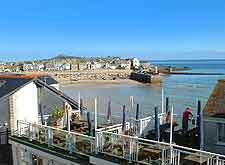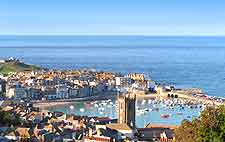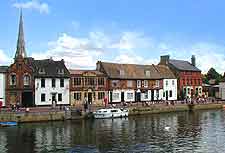St. Ives History Facts and Timeline
(St. Ives, Cornwall, England, UK)

Legend has it that when St. La, the daughter of an Irish noble, missed the boat that would take her to Cornwall, she prayed for a miracle. That miracle was a 'leaf' on which she sailed from
Ireland. She is said to have founded an oratory where she landed, the site of which is still home to the town's parish church and dedicated to her.
Early History
It is likely that St. Ives began as a small fishing settlement during prehistoric times. From the Middle Ages on, St. Ives grew into a bustling fishing port. The town prospered and, in the 13th century, St. Ives was granted a Charter by King Edward I. In 1434, the Parish Church of St. Ela was consecrated, an event that is still commemorated today with annual Feast Day activities.

St. Ives in the 17th and 18th Centuries
St. Ives was incorporated as a borough by King Charles I in 1639. The town enjoyed continued prosperity and in 1770, improvements were made to its harbour. In particular, a pier was built by John Smeaton, the man behind the famous Eddystone Lighthouse. Later in the 18th century, slate and mineral mining also came to play an important role in the town.
Modern St. Ives
At the beginning of the 19th century, fishing was still the main source of income for most of the residents of St. Ives. Boats from the port supplied pilchards to places as far flung as
Italy. As the 19th century drew to a close, however, the fishing industry fell into decline. Many boat building workshops fell silent.

In 1877, the railway came to town and St. Ives, taking advantage of a new breed of visitor, quickly established itself as a popular holiday destination. Among those visitors were several artists. It's known that Turner visited St. Ives twice, as did the marine artist Henry Moore.
From the 1920s, the town became a hotbed of modernist creativity. At the centre of the town's early artists' colony were the labyrinthine cobbled streets and alleyways of Downalong, which radiated from the town's harbour.
In January 1927, the St. Ives Society of Artists was founded. At the onset of the Second World War, the relative safety of St. Ives encouraged more artists to visit, Barbara Hepworth among them. She lived and worked here for many years, until her death in 1975. Another famous resident artist was Bernard Leach, who started a pottery in the town.
 Legend has it that when St. La, the daughter of an Irish noble, missed the boat that would take her to Cornwall, she prayed for a miracle. That miracle was a 'leaf' on which she sailed from Ireland. She is said to have founded an oratory where she landed, the site of which is still home to the town's parish church and dedicated to her.
Legend has it that when St. La, the daughter of an Irish noble, missed the boat that would take her to Cornwall, she prayed for a miracle. That miracle was a 'leaf' on which she sailed from Ireland. She is said to have founded an oratory where she landed, the site of which is still home to the town's parish church and dedicated to her.
 In 1877, the railway came to town and St. Ives, taking advantage of a new breed of visitor, quickly established itself as a popular holiday destination. Among those visitors were several artists. It's known that Turner visited St. Ives twice, as did the marine artist Henry Moore.
In 1877, the railway came to town and St. Ives, taking advantage of a new breed of visitor, quickly established itself as a popular holiday destination. Among those visitors were several artists. It's known that Turner visited St. Ives twice, as did the marine artist Henry Moore.